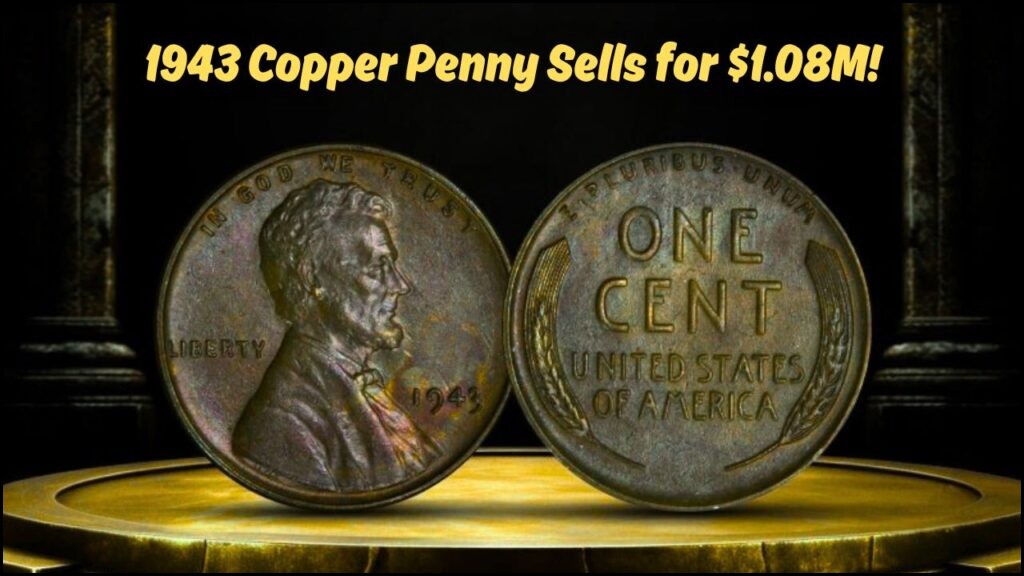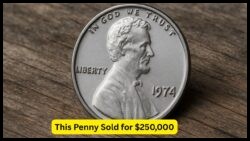1943 Copper Penny – The world of coin collecting is filled with surprises, but very few are as thrilling and profitable as the 1943 copper penny. Recently, one of these rare coins fetched a jaw-dropping $1.08 million at a prestigious auction in the United States. This event has reignited interest in coin enthusiasts, treasure hunters, and even everyday people who might unknowingly possess a fortune in their coin jars. Most people don’t realize that a simple-looking penny from decades ago could be worth more than a luxury home. The 1943 copper penny is a legendary rarity in American numismatics, and its story is rooted in a World War II-era minting anomaly. In this article, we’ll explore how this penny came into existence, why it’s so valuable, how to identify one, and where to go if you suspect you might have one lying around.
Why Is the 1943 Copper Penny So Rare?
During World War II, the U.S. Mint shifted its priorities to support the war effort.
- In 1943, pennies were supposed to be made of zinc-coated steel instead of copper.
- Copper was a valuable war material needed for ammunition and electronics.
- However, a few pennies were accidentally struck using leftover copper planchets from 1942.
- These copper pennies were not caught during production and entered circulation.
Known Facts About Its Rarity
| Year | Metal Used | Known Copper Pieces | Estimated Value |
|---|---|---|---|
| 1943 | Steel (normal) | Over 1 billion | $0.01 – $0.05 |
| 1943 | Copper (error) | Less than 20 | $250,000 – $1,800,000 |
| 1944 | Copper (normal) | Over 1 billion | Face value |
| 1944 | Steel (error) | Less than 10 | $75,000 – $400,000 |
How This Particular 1943 Penny Reached $1.08 Million
This rare coin wasn’t just sitting in someone’s attic—it was preserved and authenticated.
- The coin was sold at Heritage Auctions, a renowned platform for rare collectibles.
- The final bid hit $1.08 million, including buyer’s premium.
- The penny had been graded MS-64 Brown by the Professional Coin Grading Service (PCGS), a high grade in mint condition.
- The rarity, condition, and historical backstory made it irresistible to elite collectors.
Auction Details Snapshot
| Auction House | Final Sale Price | Date of Sale | Grading Authority | Grade |
|---|---|---|---|---|
| Heritage Auctions | $1,080,000 | July 2025 | PCGS | MS-64 Brown |
| Previous Record | $840,000 | 2019 | PCGS | MS-63 Red |
| Public Bidders | 12 | Competitive | Private & Dealers | Mixed |
How to Tell If You Have a 1943 Copper Penny
With such a huge price tag, it’s natural to wonder: could you have one of these coins?
- First, check the date — it should say 1943.
- Use a magnet — copper is not magnetic, but steel is. If it sticks, it’s steel.
- Examine the color — real copper pennies have a brown or red tint.
- Look at the weight — copper pennies weigh 3.11 grams, while steel ones weigh 2.7 grams.
- Always have it professionally authenticated by PCGS or NGC before making any assumptions.
Home Detection Guide
| Feature | Copper Penny | Steel Penny |
|---|---|---|
| Color | Brown/Red | Grey/Silver |
| Magnetic | No | Yes |
| Weight (grams) | 3.11 | 2.7 |
| Rarity | Extremely Rare | Common |
| Estimated Value | $250,000+ | Face Value |
Where to Sell or Authenticate Rare Coins in South Africa or Abroad
If you think you own a valuable coin, don’t rush to your nearest pawn shop. Instead, go through proper channels.
Trusted Authentication and Auction Services
- PCGS (Professional Coin Grading Service) – for grading and certification
- NGC (Numismatic Guaranty Corporation) – world-renowned grading firm
- Heritage Auctions – top auctioneer for rare coins
- Stack’s Bowers Galleries – another major player in rare coin auctions
- SA Coin (South Africa) – deals in international and local rare coins
Tips Before Selling
- Never clean the coin — it reduces value.
- Always get a second opinion.
- Take high-resolution photos and store the coin safely.
- Use insured and trackable shipping if sending it for grading.
Why the 1943 Penny Continues to Fascinate Collectors
The 1943 copper penny is more than just a coin; it’s a symbol of accidental rarity.
- It reflects the chaotic and hurried times during WWII.
- The mistake has now become one of the most valuable errors in minting history.
- Each penny tells a story — from discovery in pocket change to million-dollar auctions.
- This makes it an object of desire not just for collectors, but also for investors and historians.
Historical Significance
| Feature | Importance |
|---|---|
| War-time Production Error | Result of copper scarcity during WWII |
| Limited Quantity | Less than 20 confirmed worldwide |
| Iconic Numismatic Symbol | Most famous U.S. minting error ever |
| Long-Term Appreciation | Prices have grown over decades |
FAQs About the 1943 Copper Penny
Q1. Why is the 1943 copper penny so valuable?
Because it was a minting mistake — pennies in 1943 were supposed to be made from steel, not copper. Only a few were made by accident.
Q2. How many 1943 copper pennies are known to exist?
Fewer than 20 are confirmed to exist across all three U.S. mints.
Q3. Can I check if my penny is copper at home?
Yes, try the magnet test — if it sticks, it’s steel. Also, copper weighs more and looks reddish brown.
Q4. Where should I get my rare coin verified?
Use PCGS or NGC for professional grading and authentication.
Q5. Can I sell my coin for millions too?
If your coin is genuine and in good condition, yes — but it must be authenticated first and sold through reputable auction houses.






